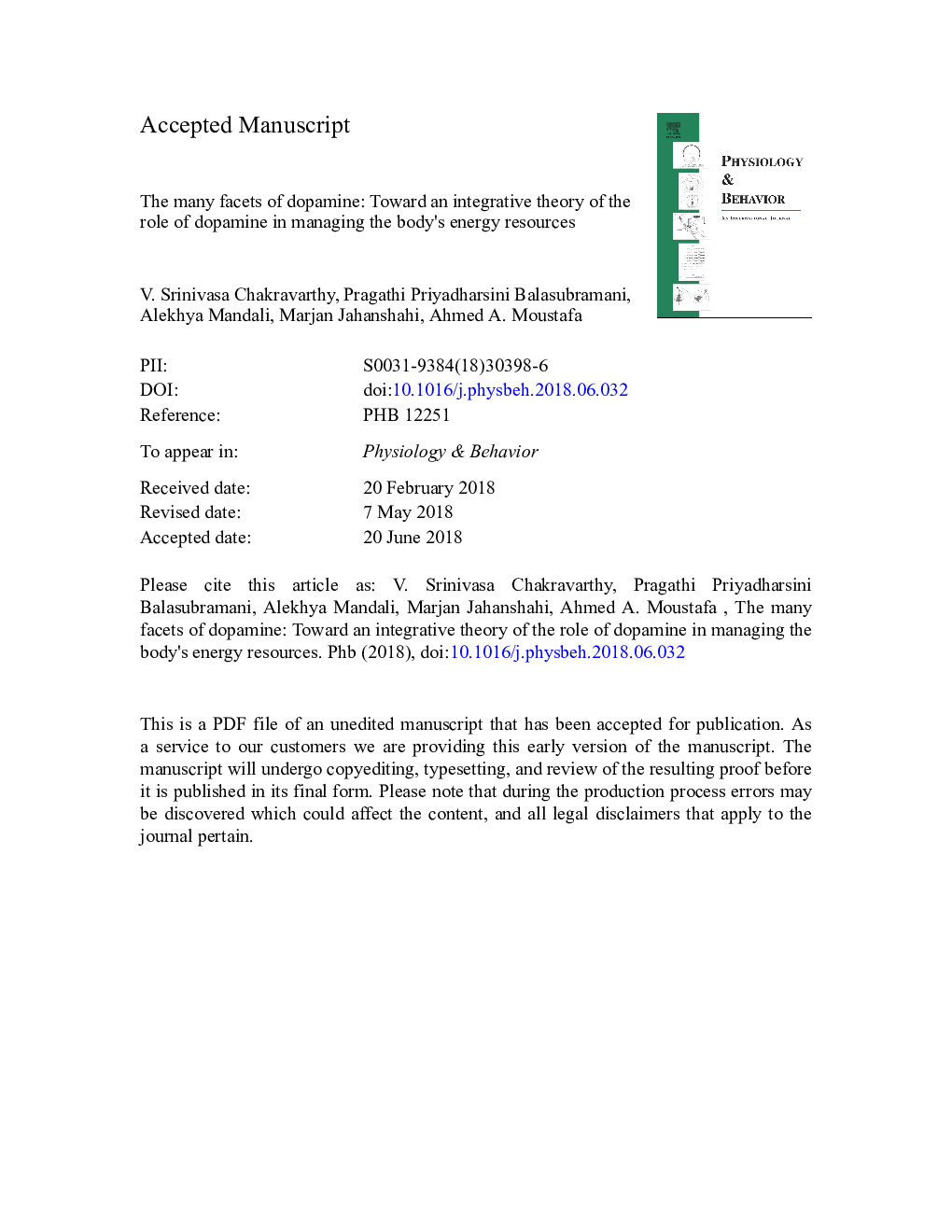| کد مقاله | کد نشریه | سال انتشار | مقاله انگلیسی | نسخه تمام متن |
|---|---|---|---|---|
| 8650202 | 1571123 | 2018 | 68 صفحه PDF | دانلود رایگان |
عنوان انگلیسی مقاله ISI
The many facets of dopamine: Toward an integrative theory of the role of dopamine in managing the body's energy resources
ترجمه فارسی عنوان
جنبه های بسیاری از دوپامین: به سوی تئوری یکپارچه سازی نقش دوپامین در مدیریت منابع انرژی بدن
دانلود مقاله + سفارش ترجمه
دانلود مقاله ISI انگلیسی
رایگان برای ایرانیان
کلمات کلیدی
دوپامین، جریان، تقویت یادگیری، اشتها جایزه،
ترجمه چکیده
در ادبیات علوم اعصاب، دوپامین اغلب به عنوان یک ماده شیمیایی لذت بخش مغز در نظر گرفته می شود. نورونهای دوپامینرژیک به محرک های پاداش که شامل پاداش های اولیه مانند مواد مخدر یا مواد غذایی یا فرم های انتزاعی پاداش مانند پاداش نقدی یا تصاویر چهره های زیبا هستند، پاسخ می دهند. این جنبه مربوط به پاداش دوپامین، به ویژه ارتباط آن با خطای پیش بینی پاداش است، که توسط یک کلاس بزرگ از مدل های محاسباتی سیگنالینگ دوپامین برجسته شده است. دوپامین همچنین یک نورومودولاتور است که کنترل پلاستیک سیناپتیک را در مناطق مختلف قشر و زیرکوریتی کنترل می کند. اما نفوذ دوپامین تنها به سیستم عصبی محدود نمی شود؛ اثرات آن نیز در سایر سیستم های فیزیولوژیکی، به ویژه سیستم گردش خون یافت می شود. مهم است که آگونیست های دوپامین به عنوان یک دارو برای کنترل فشار خون استفاده می شود. آیا یک رابطه نظری و مفهومی وجود دارد که اثرات دوپامین را در سیستم عصبی با کسانی که در سیستم گردش خون توافق می کنند، می پذیرد؟ این مقاله ی دیدگاه، نقش های مختلف فیزیولوژیکی دوپامین را در هم می آمیزد و چارچوب نظری ساده ای را ارائه می دهد که بیانگر آن است که عملکرد مربوط به پاداش، فرآیندهای مصرف انرژی و جذب بدن را تنظیم می کند. ما نتیجه می گیریم که پیشنهاد دارد که کتابداری مربوط به انرژی در سطح فیزیولوژیکی مربوط به انرژی، انگیزه مشترک است که جنبه های بسیاری از دوپامین و عملکرد آن را پیوند می دهد.
موضوعات مرتبط
علوم زیستی و بیوفناوری
بیوشیمی، ژنتیک و زیست شناسی مولکولی
فیزیولوژی
چکیده انگلیسی
In neuroscience literature, dopamine is often considered as a pleasure chemical of the brain. Dopaminergic neurons respond to rewarding stimuli which include primary rewards like opioids or food, or more abstract forms of reward like cash rewards or pictures of pretty faces. It is this reward-related aspect of dopamine, particularly its association with reward prediction error, that is highlighted by a large class of computational models of dopamine signaling. Dopamine is also a neuromodulator, controlling synaptic plasticity in several cortical and subcortical areas. But dopamine's influence is not limited to the nervous system; its effects are also found in other physiological systems, particularly the circulatory system. Importantly, dopamine agonists have been used as a drug to control blood pressure. Is there a theoretical, conceptual connection that reconciles dopamine's effects in the nervous system with those in the circulatory system? This perspective article integrates the diverse physiological roles of dopamine and provides a simple theoretical framework arguing that its reward related function regulates the processes of energy consumption and acquisition in the body. We conclude by suggesting that energy-related book-keeping of the body at the physiological level is the common motif that links the many facets of dopamine and its functions.
ناشر
Database: Elsevier - ScienceDirect (ساینس دایرکت)
Journal: Physiology & Behavior - Volume 195, 15 October 2018, Pages 128-141
Journal: Physiology & Behavior - Volume 195, 15 October 2018, Pages 128-141
نویسندگان
Srinivasa Chakravarthy, Pragathi Priyadharsini Balasubramani, Alekhya Mandali, Marjan Jahanshahi, Ahmed A. Moustafa,
